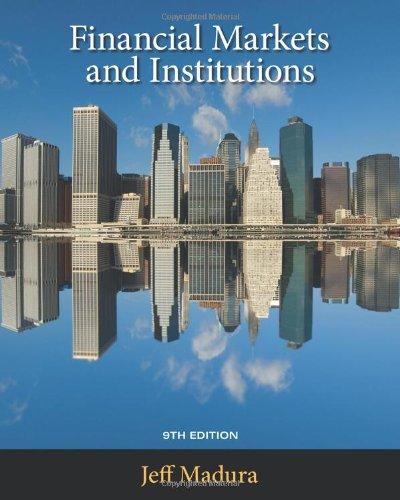Answered step by step
Verified Expert Solution
Question
1 Approved Answer
Hatfield Medical Supplys stock price had been lagging its industry averages, so its board of directors brought in a new CEO, Jaiden Lee. Lee had
| Hatfield Medical Supplys stock price had been lagging its industry averages, so its board of directors brought in a new CEO, Jaiden Lee. Lee had brought in Ashley Novak, a finance MBA who had been working for a consulting company, to replace the old CFO, and Lee asked Ashley to develop the financial planning section of the strategic plan. In her previous job, Novaks primary task had been to help clients develop financial forecasts, and that was one reason Lee hired her. | ||||||||
| Novak began as she always did, by comparing Hatfields financial ratios to the industry averages. If any ratio was substandard, she discussed it with the responsible manager to see what could be done to improve the situation. The following data shows Hatfields latest financial statements plus some ratios and other data that Novak plans to use in her analysis. | ||||||||
| Hatfield Medical Supply: Balance Sheet (Millions of Dollars), December 31 | Hatfield Medical Supply: Income Statement (Millions of Dollars Except per Share) | |||||||
| 2016 | 2016 | |||||||
| Cash | $20 | Sales | $2,000.0 | |||||
| Accts. rec. | $280 | Op. costs (excl. depr.) | $1,800.0 | |||||
| Inventories | $400 | Depreciation | $50.0 | |||||
| Total CA | $700 | EBIT | $150.0 | |||||
| Net fixed assets | $500 | Interest | $40.0 | |||||
| Total assets | $1,200 | Pretax earnings | $110.0 | |||||
| Taxes (40%) | $44.0 | |||||||
| Accts. pay. & accruals | $80 | Net income | $66.0 | |||||
| Line of credit | $0 | |||||||
| Total CL | $80 | Dividends | $20.0 | |||||
| Long-term debt | $500 | Add. to RE | $46.0 | |||||
| Total liabilities | $580 | Common shares | 10.0 | |||||
| Common stock | $420 | EPS | $6.6 | |||||
| Retained earnings | $200 | DPS | $2.0 | |||||
| Total common equ. | $620 | Ending stock price | $52.80 | |||||
| Total liab. & equity | $1,200 | |||||||
| Selected Ratios and Other Data, 2016 | ||||||||
| Hatfield | Industry | Hatfield | Industry | |||||
| (Op. costs)/Sales | 90% | 88% | (Total liabilities)/(Total assets) | 48.3% | 36.7% | |||
| Depr./FA | 10% | 12% | Times interest earned | 3.8 | 8.9 | |||
| Cash/Sales | 1% | 1% | Return on assets (ROA) | 5.5% | 10.2% | |||
| Receivables/Sales | 14% | 11% | Profit margin (M) | 3.30% | 4.99% | |||
| Inventories/Sales | 20% | 15% | Sales/Assets | 1.67 | 2.04 | |||
| Fixed assets/Sales | 25% | 22% | Assets/Equity | 1.94 | 1.58 | |||
| (Acc. pay. & accr.)/Sales | 4% | 4% | Return on equity (ROE) | 10.6% | 16.1% | |||
| Tax rate | 40% | 40% | P/E ratio | 8.0 | 16.0 | |||
| ROIC | 8.0% | 12.5% | ||||||
| NOPAT/Sales | 4.5% | 5.6% | ||||||
| (Total op. capital)/Sales | 56.0% | 45.0% | ||||||
| e. Use the following assumptions to answer the questions below: (1) Operating ratios remain unchanged. (2) Sales will grow by 10%, 8%, 5%, and 5% for the next four years. (3) The target weighted average cost of capital (WACC) is 9%. This is the No Change scenario because operations remain unchanged. | ||||||||
| e. (1) For each of the next four years, forecast the following items: sales, cash, accounts receivable, inventories, net fixed assets, accounts payable & accruals, operating costs (excluding depreciation), depreciation, and earnings before interest and taxes (EBIT). | ||||||||
| e. (2) Using the previously forecasted items, calculate for each of the next four years the net operating profit after taxes (NOPAT), net operating working capital, total operating capital, free cash flow, (FCF), annual growth rate in FCF, and return on invested capital. What does the forecasted free cash flow in the first year imply about the need for external financing? Compare the forecasted ROIC compare with the WACC. What does this imply about how well the company is performing? | ||||||||
| e. (3) Assume that FCF will continue to grow at the growth rate for the last year in the forecast horizon (Hint: 5%). What is the horizon value at 2020? What is the present value of the horizon value? What is the present value of the forecasted FCF? (Hint: use the free cash flows for 2017 through 2020). What is the current value of operations? Using information from the 2016 financial statements, what is the current estimated intrinsic stock price? | ||||||||
Step by Step Solution
There are 3 Steps involved in it
Step: 1

Get Instant Access to Expert-Tailored Solutions
See step-by-step solutions with expert insights and AI powered tools for academic success
Step: 2

Step: 3

Ace Your Homework with AI
Get the answers you need in no time with our AI-driven, step-by-step assistance
Get Started


